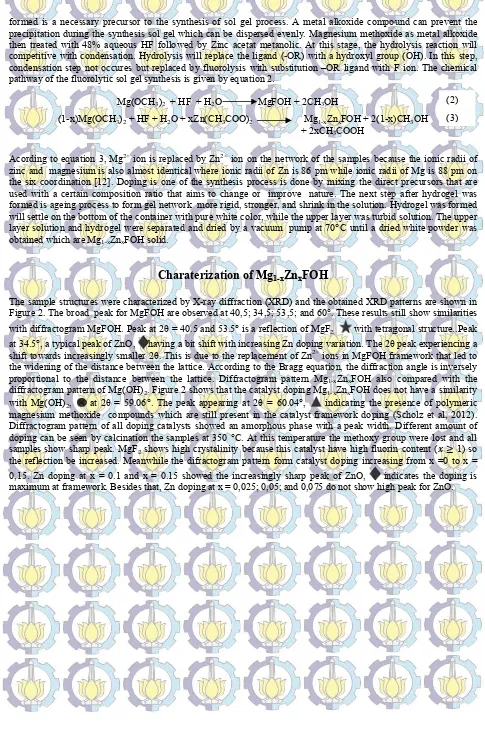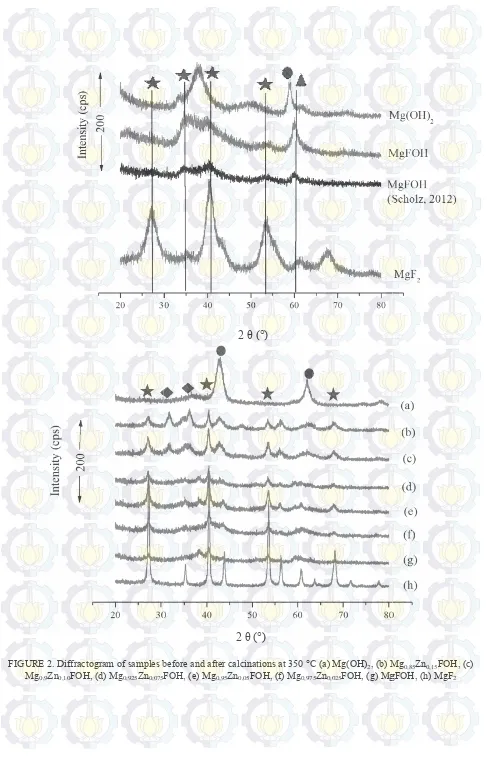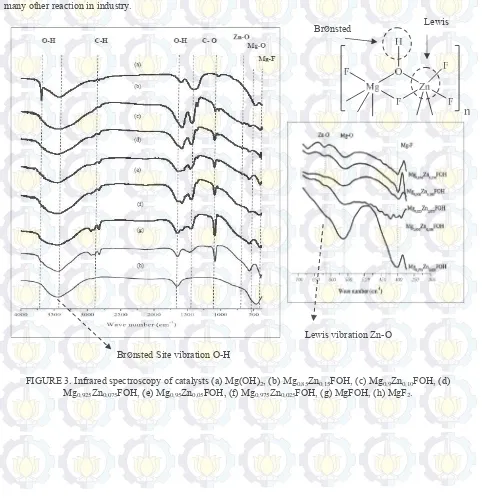Synthesis and Characterization of Zn Doped Magnesium
Hydroxyfluoride, Mg
1-x
Zn
x
FOH.
Johanis P. T. Djawa
1,b), Afifah Rosyidah
2, Harsasi Setyawati
3, and Irmina K
Murwani.
4,a)1,2,4 Department of Chemistry, Institut Teknologi Sepuluh Nopember Surabaya, Jl. Arief Rahman Hakim 60111. 3Department of Chemistry, Universitas Airlangga
a)Corresponding author: [email protected] b)[email protected]
Abstract.
A series of Zn-Doped Magnesium Hydroxyfluoride, Mg1-xZnxFOH) samples with 0 to 0.15 of x were preparedusing a sol–gel synthesis and dried with vacuum technique. XRD characterization of the samples indicated the amorphous phase of Mg1-xZnxFOH similarity with MgF2. The Zn doped in magnesium hydroxyfluoride did not affected on the basic structure of
magnesium hydroxyfluoride. The FTIR spectra showed the samples had a broad band at 3000-3700 cm-1 and 1620 cm-1 was
indicated of adsorbed H2O molecules and a bridging hydroxyl groups, respectively. The intensity of the 460, and 550 cm-1 bands
correlates to Mg-F and Mg-O vibrations. The Zn-O stretching vibration of Zn-doped magnesium hydroxyfluoride appeared at 1634 and 621 cm-1.
KEYWORDS: Sol Gel, Fluorolysis, Zn doped
INTRODUCTION
Metal fluoride is an inorganic compound that has an important role in the field of catalysis. For examples, dehydration reaction of d-xylose into furfural[1], ammoxidation of 3-picoline[2], liquid phase oxidation of ethylbenzene[3], dehydrohalogenation of 3-chloro-1,1,1,3-tetrafluorobutane[3], and acetylation of glycerol[4]. Preparation of metal fluorides catalyst has been developed primarily with a sol gel method. Sol-gel method has advantages such as homogenity in the chemical composition, low temperature and low cost[5]. In the sol gel method, a solution undergo a phase change into a sol and then into a gel. Principally, two steps for the synthesis metal oxides from metal alkoxides are hydrolysis and condensation[6]. However, in the sol gel synthesis of metal fluorides, hydrolysis is replaced by fluorolysis[7]. Synthesis of metal fluoride is based on the reaction between the metal alkoxide with hydrofluoric acid followed by reaction with the replacement group fluorolysis OR by F-[5].This
method has been successfully developed for the synthesis of magnesium fluoride. Synthesis of magnesium hydroxyfluoride can be done through a competition reaction between the hydrolysis reaction and methanolic fluorolysis using hydrofluoric acid[8]. In this paper, we reported the structure and properties of the material magnesium hydroxyfluoride with fluorolytic sol gel method. Zn doping is done to overcome the unstable of the Lewis acids catalyst where it mainly caused by moisture that involves water as a reactant, product or solvent[9]. Zn doping on the magnesium hydroxyfluoride to form Mg1-xZnxFOH have Lewis and Bronsted site can be application
METODHOLOGY
Materials
Magnesium turning Aldrich, 98%), Zinc acetate dihydrate Aldrich), Hydrofluoric acid (Sigma-Aldrich, 48%) and dried methanol (Sigma-(Sigma-Aldrich, 99%).
Synthesis of Mg
1-xZn
xFOH samples
Magnesium powder was dissolved in dried methanol at room temperature and refluxed at 70°C to prepared magnesium methoxide, Mg(OCH3)2 solution. A stoichiometric amount of HF 48% and Zinc acetate solutions was
added to magnesium methoxide solution and mixed until a hydrogel was formed. The hydrogel was Mg1-xZnxFOH
with x variations = 0; 0,025; 0,050; 0.075; 0.100; and 0.150 . The hydrogel was dried under vacuum at 70°C after aging process.
Samples Characterization
The structure of the samples was determined using X-ray Diffraction . XRD pattern were recorded on X’pert MPD X-ray diffractometer with CuKα radiation (40 kV, 30 mA) in the 2θ range from 20 to 80°. The functional group of
the samples was characterized by Fourier Transform Infrared (FTIR) spectrophotometer as pellets of KBr. Spectra were recorded between 4000 and 400 cm-1 on a Perkin-Elmer 2000 spectrometer in transmission mode.
RESULTS AND DISCUSSION
Synthesis of Mg
1-xZn
xFOH
Mg1-xZnxFOH samples in this study were synthesized by sol-gel technique. Sol-gel technique have been known to
produce a homogeneous product and take place at low temperature[10]. Precursors used in this research are magnesium metal, hydrofluoric acid (HF) as a source of F- ions, zinc acetate as a source of Zn2+ , and dried methanol
as a solvent as well as a source of alkoxide. The use of salt precursors such as nitrates, chlorides, and carbonates should be avoided because it will generate residual acid ions such as NO3- , Cl- , and CO32- which can reduce the
stability of the colloid to form aggregates[11]. Magnesium metal precursors do not produce residual ions and easily react with methanol to produced magnesium methoxide (alkoxide). Metal alkoxides were fluorolytic further by adding a 48% aqueous HF solution. The Zn doping was conducted simultaneously during the sol-gel synthesis and was obtained a white gel.
Synthesis of Mg1-xZnxFOH with a sol gel method occurs in two stages. The first stage is the formation of metal
alkoxides while the second stage is the polymerization process with HF. Phase formation occurs when the magnesium turning reacted with methanol anhyrous at 70 °C with reflux method. Heating is required at the time of reaction because magnesium is an alkaline earth metal that has low reactivity compared to alkali metals. The radius of the alkaline earth metal ions are generally smaller than the alkali metal so that the ionization energy required is greater. At the stage of making alkoxide, methanol is used so that all excess magnesium can react and form bubbles of gas produced from magnesium metal acording to reaction :
Metal alkoxides characterized by a phase change from a solution into a white emulsion. Based on the equation 1, the reaction between magnesium turning with methanol would produce magnesium methoxide. Magnesium methoxide
formed is a necessary precursor to the synthesis of sol gel process. precipitation during the synthesis sol gel which can be dispersed evenly. then treated with 48% aqueous HF followed by Zinc acetat metanolic. competitive with condensation. Hydroly
condensation step not occures but replaced by fluorolysis with pathway of the fluorolytic sol gel synthesis is given by equation
Mg(OCH3)2
(1-x)Mg(OCH3)2 + HF + H
Acording to equation 3, Mg2+ ion is replace
zinc and magnesium is also almost identical where ionic radii of Zn is 86 pm while ionic radii of Mg is 88 pm on the six coordination [12]. Doping is one of the
used with a certain composition ratio
formed is ageing process to form gel network more rigid, stronger, and shrink in the solution. will settle on the bottom of the container with
layer solution and hydrogel were separated obtained which are Mg1-xZnxFOH solid
Charaterization
The sample structures were characterized by X Figure 2. The broad peak for MgFOH are observed at with diffractogram MgFOH. Peak at 2θ = 40.5 and
at 34.5°, a typical peak of ZnO, having a bit shift with increasing Zn doping variation. shift towards increasingly smaller 2θ. This is due to the replacement
the widening of the distance between the lattice proportional to the distance between the lattice. diffractogram pattern of Mg(OH)2. Figure
with Mg(OH)2, at 2θ = 59.06°. The
magnesium methoxide compounds which are still present in the catalyst framework doping (Scholz et al, 2012). Diffractogram pattern of all doping catalysts showed an amorphous phase with a peak width
doping can be seen by calcination the samples at 350 °C. At this samples show sharp peak. MgF2 shows high crystalinity because this
the reflection be increased. Meanwhile the difractogram pattern form catalyst doping increasing 0,15. Zn doping at x = 0.1 and x = 0.15 showed the increasingly sharp peak of ZnO
maximum at framework. Besides that, Zn doping at x = 0,025; 0,05; and 0,075 do not show high peak for ZnO. formed is a necessary precursor to the synthesis of sol gel process. A metal alkoxide compound can prevent precipitation during the synthesis sol gel which can be dispersed evenly. Magnesium methoxide as metal alkoxide
followed by Zinc acetat metanolic. At this stage, the hydrolysis reaction will Hydrolysis will replace the ligand (-OR) with a hydroxyl group (OH)
not occures but replaced by fluorolysis with substitution –OR ligand with F ion. synthesis is given by equation 2.
+ HF + H2O MgFOH + 2CH3OH
+ HF + H2O + xZn(CH3COO)2 Mg1-xZnxFOH + 2(1-x)CH
+ 2xCH3COOH
replaced by Zn2+ ion on the network of the samples because
zinc and magnesium is also almost identical where ionic radii of Zn is 86 pm while ionic radii of Mg is 88 pm on is one of the synthesis process is done by mixing the direct
that aims to change or improve nature. The next step is ageing process to form gel network more rigid, stronger, and shrink in the solution. Hydrog
bottom of the container with pure white color, while the upper layer was turbid solution eparated and dried by a vacuum pump at 70°C until a dried solid.
Charaterization of Mg
1-xZn
xFOH
were characterized by X-ray diffraction (XRD) and the obtained XRD pattern
for MgFOH are observed at 40,5; 34,5; 53,5; and 60°. These results still show similarities with diffractogram MgFOH. Peak at 2θ = 40.5 and 53.5° is a reflection of MgF2, with tetragonal str
having a bit shift with increasing Zn doping variation. The 2θ peak experiencing a shift towards increasingly smaller 2θ. This is due to the replacement of Zn2+ ions in MgFOH framework that led to
the widening of the distance between the lattice. According to the Bragg equation, the diffraction angle is inversely proportional to the distance between the lattice. Diffractogram pattern Mg1-xZnxFOH also compared wit
Figure 2 shows that the catalyst doping Mg1-xZnxFOH does not have a
°. The peak appearing at 2θ = 60.04°, indicating the presence of polymeric which are still present in the catalyst framework doping (Scholz et al, 2012). Diffractogram pattern of all doping catalysts showed an amorphous phase with a peak width.
doping can be seen by calcination the samples at 350 °C. At this temperature the methoxy group were lost and all shows high crystalinity because this catalyst have high fluorin content (
the reflection be increased. Meanwhile the difractogram pattern form catalyst doping increasing
n doping at x = 0.1 and x = 0.15 showed the increasingly sharp peak of ZnO, indicates the doping is maximum at framework. Besides that, Zn doping at x = 0,025; 0,05; and 0,075 do not show high peak for ZnO.
metal alkoxide compound can prevent the um methoxide as metal alkoxide
the hydrolysis reaction will ) with a hydroxyl group (OH). In this step, OR ligand with F ion. The chemical
x)CH3OH
on the network of the samples because the ionic radii of zinc and magnesium is also almost identical where ionic radii of Zn is 86 pm while ionic radii of Mg is 88 pm on direct precursors that are ions in MgFOH framework that led to ccording to the Bragg equation, the diffraction angle is inversely also compared with the does not have a similarity indicating the presence of polymeric which are still present in the catalyst framework doping (Scholz et al, 2012).
Different amount of temperature the methoxy group were lost and all catalyst have high fluorin content ( ≥ 1) so the reflection be increased. Meanwhile the difractogram pattern form catalyst doping increasing from x =0 to x = indicates the doping is maximum at framework. Besides that, Zn doping at x = 0,025; 0,05; and 0,075 do not show high peak for ZnO.
FIGURE 2. Diffractogram of samples before and after calcinations at 350 °C Mg0,9Zn0,10FOH, (d) Mg0,925Zn0,075FOH, (e) Mg
before and after calcinations at 350 °C (a) Mg(OH)2, (b) Mg
FOH, (e) Mg0,95Zn0,05FOH, (f) Mg0,975Zn0,025FOH, (g) MgFOH, (h) MgF
2 θ (°)
2 θ (°)
, (b) Mg0,85Zn0,15FOH, (c)
All samples were investigated by FTIR to clarify the vibration group. The presence of Bronsted acid groups can be seen from OH vibration bridging at 3500 – 3200 cm-1 [13][14]. The infrared spectrum also provide information
about the bond that is formed on the samples. In Figure 3, the vibrations are observed on the band of 3000 and 2750 cm-1 (CH) suggest the presence of a methoxy group reinforced with υ (CO) vibrations in the wave number 1080 cm-1
.Strong vibration also observed at 1460 cm-1 which is a vibration δ (CH
3) methoxy group. In addition, absorption
band at 1400 - 1500 cm-1 indicated the presence of bicarbonate compounds produced from the reaction of CO 2 with
free hydroxyl groups on the surface of the sample [15]. Absorption band appeared at 1640 cm-1 and a broad band
between 3675 and 3290 cm-1 related to water adsorbed on the surface of the sample [13]. The spectrum of Mg(OH) 2
has a very strong band at 3700 cm-1 for OH group characteristic isolated of brucite [12]. Absorption band at 3700
cm-1 showed a decrease in the intensity of the bridge OH group in the sample. The Vibration of Mg-O and Mg-F is also observed at 550 and 460 cm-1 displayed in figure 4. Meanwhile, the metal doping on MgFOH samples were
characterized by Zn-O stretching vibrations in the absorption bands at 620 and 1634 cm-1[15]. Zn doping on the
catalyst increase the Lewis acid site. Lewis acid can be definition as an acid that has an electron pair acceptor. It is caused by Zn2+ ion has lone pair orbital. Meanwhile Bronsted acid site obtained from MgFOH that has bridging
interaction between F and Mg or Zn atom. Bronsted acid is an acid that can donate protons. The effect Zn doping on the catalyst will reduce the Bronsted acid site because Zn doping increase the Lewis acid site. BrØnsted site and
Lewis acid is very important in catalysis reaction such as isomerization, alkylation, asilation, esterification and many other reaction in industry.
FIGURE 3. Infrared spectroscopy of catalysts (a) Mg(OH)2, (b) Mg0,85Zn0,15FOH, (c) Mg0,9Zn0,10FOH, (d)
Mg0,925Zn0,075FOH, (e) Mg0,95Zn0,05FOH, (f) Mg0,975Zn0,025FOH, (g) MgFOH, (h) MgF2.
BrØnsted Lewis
BrØnsted Site vibration O-H
CONCLUSIONS
Sol-gel synthesis of metal fluoride Mg1-xZnxFOH with aqueous hydrofluoric acid produces amorphous phase. OH
bridge is observed within the framework of the material shows Brønsted acid sites. Meanwhile, Lewis acid sites were obtained from doping Zn on MgFOH.
ACKNOWLEDGEMENT
The authors gratefully acknowledge to head of Material and Energy Laboratory Department of Chemistry, Institut Teknologi Sepuluh Nopember, Surabaya
[1] I. Agirrezabal-Telleria, F. Hemmann, C. Jäger, P. L. Arias, and E. Kemnitz, “Functionalized partially
hydroxylated MgF2 as catalysts for the dehydration of d-xylose to furfural,” J. Catalysis., vol. 305, pp. 81–91, Sep. 2013.
[2] V. N. Kalevaru, B. D. Raju, V. V. Rao, and A. Martin, “Ammoxidation of 3-picoline over V2O5/MgF2 catalysts: Correlations between nicotinonitrile yield and O2 and NH3 chemisorption properties,” Catal. Commun., vol. 9, no. 5, pp. 715–720, Mar. 2008.
[3] I. K. Murwani, K. Scheurell, and E. Kemnitz, “Liquid phase oxidation of ethylbenzene on pure and metal doped HS-AlF3,” Catal. Commun., vol. 10, no. 2, pp. 227–231, Nov. 2008.
[4] S. B. Troncea, S. Wuttke, E. Kemnitz, S. M. Coman, and V. I. Parvulescu, “Hydroxylated magnesium fluorides as environmentally friendly catalysts for glycerol acetylation,” Appl. Catal. B Environ., vol. 107, no. 3, pp. 260–267, 2011.
[5] P. T. Patil, A. Dimitrov, J. Radnik, and E. Kemnitz, “Sol–gel synthesis of metal fluoride supported Pd catalysts for Suzuki coupling,” J Mater Chem, vol. 18, no. 14, pp. 1632–1635, Mar. 2008.
[6] G. Lakshminarayana, J. A. Torres, T. C. Lin, I. V. Kityk, and M. P. Hehlen, “Sol–gel synthesis and characterization of fluoride-rich lanthanum-alumino-silicate gels doped with Ce3+ and Ti4+,” J. Alloys Compd., vol. 601, pp. 67–74, Jul. 2014.
[7] S. Rüdiger, U. Groß, and E. Kemnitz, “Non-aqueous sol–gel synthesis of nano-structured metal fluorides,” J. Fluor. Chem., vol. 128, no. 4, pp. 353–368, Apr. 2007.
[8] S. Wuttke, S. M. Coman, G. Scholz, H. Kirmse, A. Vimont, M. Daturi, S. L. M. Schroeder, and E. Kemnitz, “Novel Sol-Gel Synthesis of Acidic MgF2−x(OH)x Materials,” Chem. - Eur. J., vol. 14, no. 36, pp. 11488– 11499, Nov. 2008.
[9] S. Wuttke, A. Negoi, N. Gheorghe, V. Kuncser, E. Kemnitz, V. Parvulescu, and S. M. Coman, “Sn-doped hydroxylated MgF catalysts for the fast and selective saccharification of cellulose to glucose,”
ChemSusChem, vol. 5, no. 9, pp. 1708–1711, Sep. 2012.
[10] M. Wojciechowska, M. Zieliński, and M. Pietrowski, “MgF2 as a non-conventional catalyst support,” J. Fluor. Chem., vol. 120, no. 1, pp. 1–11, Mar. 2003.
[11] J. G. Quiñones-Galván, I. M. Sandoval-Jiménez, H. Tototzintle-Huitle, L. A. Hernández-Hernández, F. de Moure-Flores, A. Hernández-Hernández, E. Campos-González, A. Guillén-Cervantes, O. Zelaya-Angel, and J. J. Araiza-Ibarra, “Effect of precursor solution and annealing temperature on the physical properties of Sol– Gel-deposited ZnO thin films,” Results Phys., vol. 3, pp. 248–253, 2013.
[12] J. E. Huheey, Inorganic Chemistry: Principles of Structure and Reactivity. Delhi, India: Dorling Kindersley Pvt Ltd, 2008.
[13] G. Scholz, C. Stosiek, M. Feist, and E. Kemnitz, “Magnesium Hydroxide Fluorides–New Materials with Adjustable Composition and Properties,” Eur. J. Inorg. Chem., vol. 2012, no. 14, pp. 2337–2340, 2012. [14] H. A. Prescott, Z.-J. Li, E. Kemnitz, J. Deutsch, and H. Lieske, “New magnesium oxide fluorides with
hydroxy groups as catalysts for Michael additions,” J. Mater. Chem., vol. 15, no. 43, pp. 4616–4628, Oct. 2005.
[15] Infrared and Raman Spectra of Inorganic and Coordination Compounds, Theory and Applications in Inorganic Chemistry, Part A edition. Hoboken, N.J: Wiley-Interscience, 2009.


